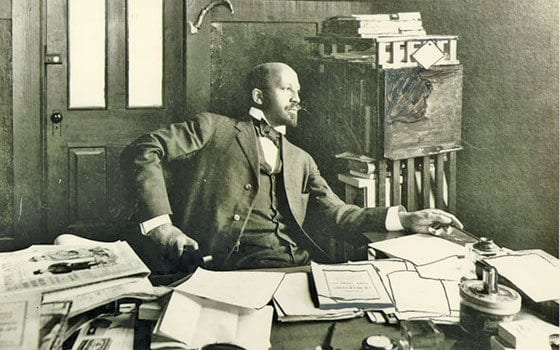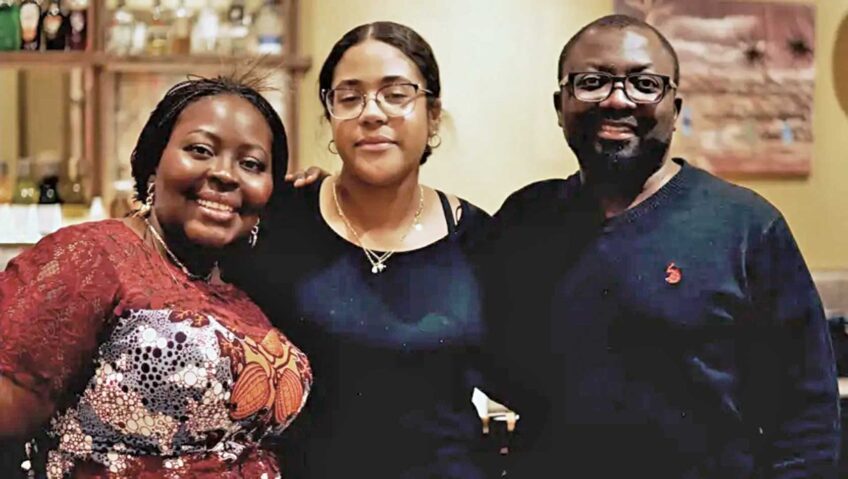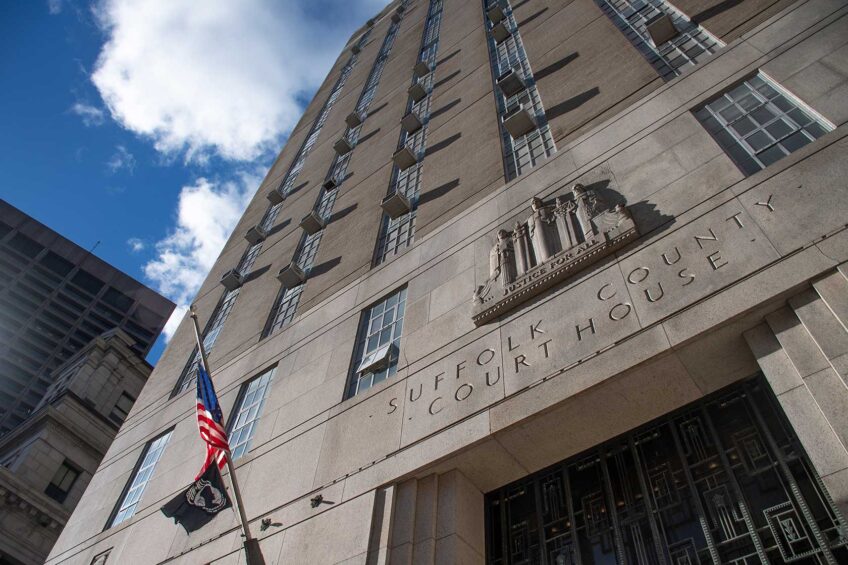


Author: University of Massachusetts at Amherst W.E.B. Du Bois LibraryTo commemorate W.E.B. Du Bois’ 142nd birthday on February 23, UMass Amherst will host its annual Du Bois Lecture in the Cape Cod Lounge Thursday, Feb. 25 at 7 p.m. Du Bois is shown above in his office at Atlanta University in 1909.

Author: University of Massachusetts at Amherst W.E.B. Du Bois LibraryTo commemorate W.E.B. Du Bois’ 142nd birthday on February 23, UMass Amherst will host its annual Du Bois Lecture in the Cape Cod Lounge Thursday, Feb. 25 at 7 p.m. Du Bois is shown above in his office at Atlanta University in 1909.
GREAT BARRINGTON, Mass. — On Route 23 west of Great Barrington, just north of Root Pond, only a few signs and a small, gravel parking lot mark the spot where once stood the childhood home of W.E.B. Du Bois, one of the 20th century’s most prolific intellectuals.
The site isn’t flashy, and it isn’t meant to be. It’s intended as a tranquil place for visitors to consider Du Bois’ complex career that included founding the Niagara Movement and the NAACP.
But the handful of markers is only the beginning. The Friends of the W.E.B. Du Bois Homesite have ambitious plans for the future, including new facilities, new signage for significant locations within Great Barrington and a downtown visitors’ center that will provide context and connection for the various sites.
“The vision … has expanded beyond the Homesite to tell the story of Du Bois and to honor the Du Bois legacy throughout Great Barrington,” said Rachel Fletcher, trustee of the Great Barrington Land Conservancy and member of the Friends of the W.E.B. Du Bois Homesite.
A biting social critic whose late-life conversion to Communism brought scorn from many — and opposition to the Homesite from some locals — Du Bois has become a source of great regional pride over the years.
Wray Gunn, a trustee of Clinton A.M.E. Zion Church and member of the Friends summed it up, “When you stop and figure that here was … a person who received awards from many different countries and he came from Great Barrington, it’s really special. Really special. Because not too many people have that distinction.”
The Homesite is one of several locations around Great Barrington where Du Bois lived in his youth and the home of generations of his mother’s family, the Burghardts, who were part of the small but relatively prosperous African American community in the area. In a written memory of his taking possession of the property in 1928, Du Bois wrote:
“It is the first home that I remember. There my mother was born and all her nine brothers and sisters. … It was a delectable place — simple, square and low, with the great room of the fireplace, the flagged kitchen, half a step below, and the lower woodshed beyond. Steep, strong stairs led up to Sleep, while without was a brook, a well and a mighty elm.”
Today, all that remains is the tumbled-down chimney and part of the foundation. The rest of the house is long gone, torn down in the 1950s after many years of decay — despite earlier efforts by Du Bois to make it liveable again.
The site became a memorial to Du Bois in 1969 and a National Historic Landmark in 1979. In 1987, it became state property and maintained by UMass Amherst. But until recently, little had been done to draw visitors or help them understand the site’s significance. That changed in 2008 when UMass Amherst Chancellor Thomas Cole secured funds to build the parking lot and add new signs that helped explain Du Bois’ significance.
That same year, the Friends became stewards of the Homesite and worked with UMass Amhert’s W.E.B. Du Bois Legacy Committee and the Upper Housatonic Valley African American Heritage Trail to begin a series of workshops to develop plans for the future of the site.
Even before UMass took possession of the Homesite, it was of interest to the archeologists from the university looking for more information about early African Americans in New England. Their lives were scarcely recorded in their own time and have been underappreciated subsequently. The department of archeology at UMass operated field schools at the site in 1983, 1984 and 2003 that uncovered nearly 30,000 artifacts, and another is planned for the summer of 2011.
Whitney Battle-Baptiste, an assistant professor of anthropology at UMass who will participate in the 2011 field school, said archeology could be a valuable tool for filling in gaps in the historical record. She hopes that public outreach will be “a way to connect … as opposed to having archeologists doing archeology and historians doing historical research and the two never really crossing paths and getting into … conversations with each other.”
Archeology is just one of the ways that UMass Amherst helps promote greater knowledge and understanding of Du Bois and his times. The W.E.B. Du Bois Center, created in 2009, works to unite the various activities at UMass connected to Du Bois and his legacy, including work related to the Homesite, research on Du Bois and related topics, courses in African American history, the annual Du Bois Day lecture and the digitization of Du Bois’ personal papers.
The digitization project, funded by a $200,000 grant from the Verizon Foundation, will make 100,000 items from UMass Amherst’s Du Bois collection available online, including original diaries, letters, photographs, memorabilia and other related material. Scanning began in July 2009, and UMass plans to launch the Web site containing the first batch of materials by this summer, with the project to be completed by summer 2011.
Robert Cox, the head of special collections and university archives at UMass Amerherst’s W.E.B. Du Bois Library, said the center is intended to serve historians but also ordinary citizens. “The center … can help scholarship by bringing people together to talk about ideas and so forth,” he said, “but we can also help the people of the commonwealth by learning what people need from universities and colleges.”
Events commemorating Du Bois’ 142nd birthday on Feb. 23 are planned at both UMass Amherst and Great Barrington. On Thursday, Feb. 25, at 7 p.m., UMass Amherst will host its annual Du Bois Lecture in the Cape Cod Lounge of the student union with a speech by Dr. Evelyn Brooks Higginbotham, chair of the Department of African and African American Studies at Harvard University.
In Great Barrington, the Clinton A.M.E. Zion Church will host a birthday celebration beginning at 2:30 p.m. on Saturday, Feb. 27, featuring a keynote address by Gene Dattel, author of “Cotton and Race in the Making of America.”






